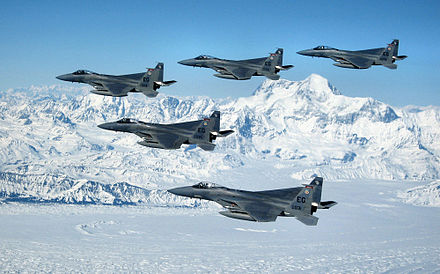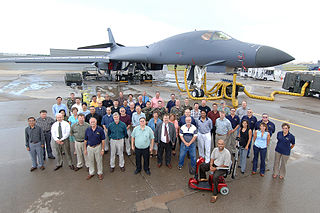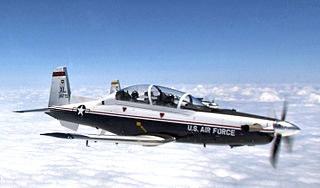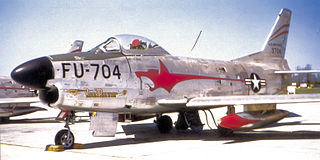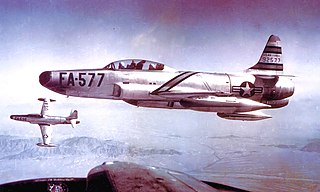| 33d Operations Group | |
|---|---|
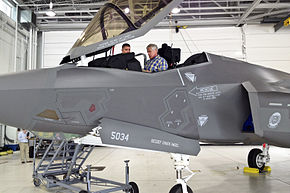 | |
| Active | 1941–1945; 1946–1952; 1955–1957; 1991–present |
| Country | |
| Branch | |
| Role | Fighter operations and training |
| Part of | 33d Fighter Wing |
| Garrison/HQ | Eglin Air Force Base |
| Nickname(s) | Nomads |
| Motto(s) | Fire From the Clouds |
| Engagements | Mediterranean Theater of Operations China Burma India Theater Vietnam War |
| Decorations | Distinguished Unit Citation Air Force Outstanding Unit Award |
| Commanders | |
| Notable commanders | Col. Elwood R. Quesada Col. William W. Momyer |
| Insignia | |
| 33d Operations Group emblem (approved 21 February 1942) [1] [note 1] | 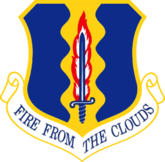 |
| Patch with 33d Tactical Group emblem | 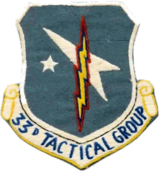 |
The 33d Operations Group is the flying component of the 33d Fighter Wing, assigned to Air Education and Training Command of the United States Air Force. The group is stationed at Eglin Air Force Base, Florida.

Air Education and Training Command (AETC) was established 1 July 1993, with the realignment of Air Training Command and Air University. It is one of the U.S. Air Force's ten major commands and reports to Headquarters, United States Air Force.

The United States Air Force (USAF) is the aerial and space warfare service branch of the United States Armed Forces. It is one of the five branches of the United States Armed Forces, and one of the seven American uniformed services. Initially formed as a part of the United States Army on 1 August 1907, the USAF was established as a separate branch of the U.S. Armed Forces on 18 September 1947 with the passing of the National Security Act of 1947. It is the youngest branch of the U.S. Armed Forces, and the fourth in order of precedence. The USAF is the largest and most technologically advanced air force in the world. The Air Force articulates its core missions as air and space superiority, global integrated intelligence, surveillance, and reconnaissance, rapid global mobility, global strike, and command and control.

Eglin Air Force Base (AFB) is a United States Air Force base in western Florida, located about three miles (5 km) southwest of Valparaiso in Okaloosa County.
Contents
- Overview
- Mission
- Units
- History
- World War II
- Occupation forces
- Cold War
- Vietnam War
- Contingency operations
- Lightning II training
- Lineage
- Assignments
- Components
- Stations
- Awards and campaigns
- Aircraft
- See also
- References
- Notes
- Citations
- Bibliography
- External links
The group was first activated in January 1941 as the 33d Pursuit Group and began training in fighter operations at Mitchel Field, New York. Following the attack on Pearl Harbor the group moved to Philadelphia, where it assumed an air defense role while training for combat. After being redesignated the 33d Fighter Group, it moved to the Mediterranean Theater of Operations in November 1942 as part of Operation Torch, the invasion of North Africa, flying its planes to its first base in Morocco from the aircraft carrier USS Chenango of the United States Navy. The group served in North Africa and Italy until February 1944, earning a Distinguished Unit Citation in January 1943 for its defense of its base from attacks by German and Italian aircraft.
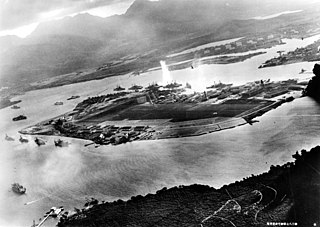
The Attack on Pearl Harbor was a surprise military strike by the Imperial Japanese Navy Air Service against the United States naval base at Pearl Harbor, Hawaii Territory, on the morning of December 7, 1941. The attack, also known as the Battle of Pearl Harbor, led to the United States' formal entry into World War II. The Japanese military leadership referred to the attack as the Hawaii Operation and Operation AI, and as Operation Z during its planning.

Philadelphia, sometimes known colloquially as Philly, is the largest city in the U.S. state and Commonwealth of Pennsylvania, and the sixth-most populous U.S. city, with a 2017 census-estimated population of 1,580,863. Since 1854, the city has been coterminous with Philadelphia County, the most populous county in Pennsylvania and the urban core of the eighth-largest U.S. metropolitan statistical area, with over 6 million residents as of 2017. Philadelphia is also the economic and cultural anchor of the greater Delaware Valley, located along the lower Delaware and Schuylkill Rivers, within the Northeast megalopolis. The Delaware Valley's population of 7.2 million ranks it as the eighth-largest combined statistical area in the United States.
The Mediterranean Theater of Operations, United States Army (MTOUSA), originally called the North African Theater of Operations (NATOUSA), was the American term for the theater of operations covering North Africa and Italy during World War II. American operations in the theater began with the Allied Expeditionary Force, which landed on the beaches of northwest Africa on November 8, 1942, in Operation Torch. They ended in the Italian Alps some 31 months later with the German surrender in May 1945.
In 1944, the group departed Italy for the China-Burma-India Theater, leaving its Curtiss P-40 Warhawks behind for Lockheed P-38 Lightnings and Republic P-47 Thunderbolts. It continued combat operations until the surrender of Japan. In November 1945, it returned to the United States and was inactivated when it arrived at the Port of Embarkation.

The Curtiss P-40 Warhawk is an American single-engined, single-seat, all-metal fighter and ground-attack aircraft that first flew in 1938. The P-40 design was a modification of the previous Curtiss P-36 Hawk which reduced development time and enabled a rapid entry into production and operational service. The Warhawk was used by most Allied powers during World War II, and remained in frontline service until the end of the war. It was the third most-produced American fighter of World War II, after the P-51 and P-47; by November 1944, when production of the P-40 ceased, 13,738 had been built, all at Curtiss-Wright Corporation's main production facilities at Buffalo, New York.

The Lockheed P-38 Lightning is a World War II–era American piston-engined fighter aircraft. Developed for the United States Army Air Corps, the P-38 had distinctive twin booms and a central nacelle containing the cockpit and armament. Allied propaganda claimed it had been nicknamed the fork-tailed devil by the Luftwaffe and "two planes, one pilot" by the Japanese. The P-38 was used for interception, dive bombing, level bombing, ground attack, night fighting, photo reconnaissance, radar and visual pathfinding for bombers and evacuation missions, and extensively as a long-range escort fighter when equipped with drop tanks under its wings.

The Republic P-47 Thunderbolt was a World War II era fighter aircraft produced by the United States from 1941 through 1945. Its primary armament was eight .50-caliber machine guns and in the fighter-bomber ground-attack role it could carry five-inch rockets or a bomb load of 2,500 pounds (1,103 kg). When fully loaded the P-47 weighed up to eight tons (tonnes) making it one of the heaviest fighters of the war. The P-47 was designed around the powerful Pratt & Whitney R-2800 Double Wasp engine which was also used by two U.S. Navy fighters, the Grumman F6F Hellcat and the Vought F4U Corsair. The Thunderbolt was effective as a short-to-medium range escort fighter in high-altitude air-to-air combat and ground attack in both the World War II European and Pacific theaters.
The group was activated as part of the Occupation Forces at Neubiberg Air Base, Germany, where it took over the personnel and equipment of the 357th Fighter Group, which was inactivated and transferred to the National Guard. In July 1947, its personnel became the cadre for the 86th Composite Group, while the group made two moves without personnel or equipment before arriving at Roswell Army Air Field, where it equipped with North American P-51 Mustangs and became part of the fledgling Strategic Air Command. A year later, it received its first jet aircraft, the Republic F-84 Thunderjet. In 1948. the group moved to Otis Air Force Base, Massachusetts, where it assumed an air defense role, first under Continental Air Command, then under Air Defense Command (ADC) as the 33d Fighter-Interceptor Group. It was inactivated in February 1952 when ADC reorganized its forces on a geographic basis.
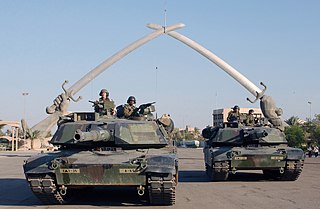
Military or belligerent occupation is effective provisional control by a certain ruling power over a territory, which is not under the formal sovereignty of that entity, without the violation of the actual sovereign. The territory is then known as the occupied territory and the ruling power the occupant. Occupation is distinguished from annexation by its intended temporary nature, by its military nature, and by citizenship rights of the controlling power not being conferred upon the subjugated population.

Neubiberg Air Base is a former German Air Force and United States Air Force airfield which was closed in 1991. It is located 9 km south of the city of Munich, Germany.

The 357th Fighter Group was an air combat unit of the United States Army Air Forces during the Second World War. The 357th operated P-51 Mustang aircraft as part of the U.S. Eighth Air Force and its members were known unofficially as the Yoxford Boys after the village of Yoxford near their base in the UK. Its victory totals in air-to-air combat are the most of any P-51 group in the Eighth Air Force and third among all groups fighting in Europe.
ADC activated the group, once more the 33d Fighter Group, at Otis in August 1955 as part of Project Arrow, a program to replace ADC's Air Defense Groups with fighter groups with distinguished combat records in World War II. As Otis expanded to add the airborne early warning and control mission the following year, the group's support units were transferred to the newly reactivated 33d Fighter Wing. In 1957, the group and wing were inactivated and the group's flying squadrons were transferred to the Boston Air Defense Sector

World War II, also known as the Second World War, was a global war that lasted from 1939 to 1945. The vast majority of the world's countries—including all the great powers—eventually formed two opposing military alliances: the Allies and the Axis. A state of total war emerged, directly involving more than 100 million people from over 30 countries. The major participants threw their entire economic, industrial, and scientific capabilities behind the war effort, blurring the distinction between civilian and military resources. World War II was the deadliest conflict in human history, marked by 50 to 85 million fatalities, most of whom were civilians in the Soviet Union and China. It included massacres, the genocide of the Holocaust, strategic bombing, premeditated death from starvation and disease, and the only use of nuclear weapons in war.

An airborne early warning and control (AEW&C) system is an airborne radar picket system designed to detect aircraft, ships and vehicles at long ranges and perform command and control of the battlespace in an air engagement by directing fighter and attack aircraft strikes. AEW&C units are also used to carry out surveillance, including over ground targets and frequently perform C2BM functions similar to an Air Traffic Controller given military command over other forces. When used at altitude, the radar on the aircraft allows the operators to detect and track targets and distinguish between friendly and hostile aircraft much farther away than a similar ground-based radar. Like a ground-based radar, it can be detected by opposing forces, but because of its mobility, it is much less vulnerable to counter-attack.

The Boston Air Defense Sector (BADS) is an inactive United States Air Force Air Defense Command (ADC) organization. Its last assignment was with the ADC 26th Air Division at Hancock Field, New York.
As the United States Air Force implemented the Objective wing reorganization in 1991, the 33d, now designated the 33d Operations Group, was activated to command the 33d Fighter Wing's operational units. It flew the McDonnell Douglas F-15 Eagle until 2009, when it began the transition to the Lockheed Martin F-35 Lightning II Joint Strike Fighter.

The McDonnell Douglas F-15 Eagle is an American twin-engined, all-weather tactical fighter aircraft designed by McDonnell Douglas to gain and maintain air supremacy in all aspects of aerial combat. Following reviews of proposals, the United States Air Force selected McDonnell Douglas's design in 1967 to meet the service's need for a dedicated air-superiority fighter. The Eagle first flew in July 1972, and entered service in 1976. It is among the most successful modern fighters, with over 100 victories and no losses in aerial combat, with the majority of the kills by the Israeli Air Force.
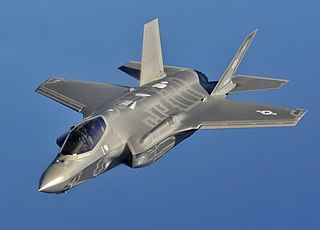
The Lockheed Martin F-35 Lightning II is a family of single-seat, single-engine, all-weather stealth multirole fighters. The fifth-generation combat aircraft is designed to perform ground-attack and air-superiority missions. It has three main models: the F-35A conventional takeoff and landing (CTOL) variant, the F-35B short take-off and vertical-landing (STOVL) variant, and the F-35C carrier-based catapult-assisted take-off but arrested recovery (CATOBAR) variant. The F-35 descends from the Lockheed Martin X-35, the winning design of the Joint Strike Fighter (JSF) program. It is built by Lockheed and many subcontractors, including Northrop Grumman, Pratt & Whitney, and BAE Systems.




